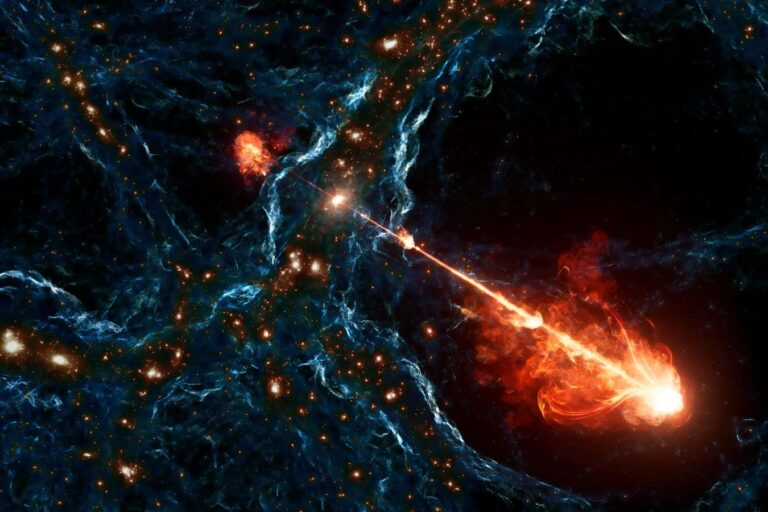Illustration of the massive black hole jet known as Porphyrion
California Institute of Technology
The twin jets emanating from the black hole stretch for 23 million light-years, the length of 220 Milky Way galaxies – so large that they could change our understanding of both black holes and the structure of the universe.
“If you think of the jet as an object, you could say it’s the largest object we know of in the universe,” he said. Martin Hardcastle At the University of Hertfordshire, UK.
The jet, which Hardcastle and his colleagues call Porphyrion, comes from a black hole in a distant galaxy about 7.5 billion light-years away, and the light from the jet that reaches us today began its journey when the universe was only 6.3 billion years old, about half its current age.
The researchers identified this jet and at least 10 other pairs of similar jets that are millions of light-years wide. Low Frequency Array (LOFAR) Telescopeconsists of thousands of radio antennas spread across many European countries. Follow-up observations using telescopes in India and Hawaii have since pinpointed the location of the host galaxy.
To produce such a massive jet, the black hole would have had to swallow a sun’s worth of material every year for a billion years, Hardcastle said. As the material fell into the black hole during this time, some of it was twisted and accelerated by the black hole’s magnetic field, spewing it out into space to form the jet.
“In the early universe, matter was denser than it is today, so it’s unusual for a jet to persist for such a long time without being disturbed by another cosmic object,” Hardcastle said. “This is back to a time in the universe when galaxies were very active. There was a lot going on, and this black hole has been spewing out more or less unchecked for a billion years.”
“I never thought this would be possible,” he said. Laura Olivera Nieto “Simply put, [jet] for a long time.”
Even simulating how such a huge beam would form and what its effects would be is extremely difficult because of the distances involved, she says: “It’s really hard to understand how this is physically possible. You can’t put it on a computer; it’s too big.”
Porphyrion extends far enough to influence the formation of other galaxies, potentially injecting energy and magnetic fields into other regions, Hardcastle says. This could also help solve the mystery of where the universe’s magnetic fields come from. “Porphyrion emits energy and magnetic fields and particles into the gaps between galaxies,” Hardcastle says. “This is a mechanism that transports magnetic fields from very small scales to very large scales.”
These jets could also undermine some cosmological theories that assume that objects like black holes don’t affect large areas of the universe.
“Results like these show that if we want to understand how the large-scale structure of the universe forms and evolves, we also need to consider how its smaller components, such as outflowing systems, influence it,” Olivera Nieto says.
topic:


